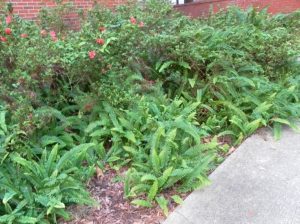Nephrolepis cordifolia (Sword fern)

Nephrolepis cordifolia is a member of the Nephrolepidaeae family. Also called sword fern, the plant is considered to be a Category I Invasive Plant Species by the FLEPPC (Florida Exotic Plant Pest Council) (MacDonald et al. 2008, Wunderlin and Hansen 2008). It is present throughout Florida, notably Gainesville south since its introduction into the state (MacDonald
et al. 2008).

The tuberous sword fern is often found in wooded areas, such as a hydric hammock community. This woody fern competes with native plants and can often displace them. Reproduction via spores allows the sword fern to reproduce quickly and in high numbers because it can produce thousands of spores year round. These spores can be spread by water or by wind and grow quickly into dense undergrowth (MacDonald et al. 2008).


The fern has pinnate fronds that can grow to three feet long and nearly three inches wide. Each frond may have 80-200 leaflets that are oblong to lanceolate shaped (MacDonald et al. 2008). An interesting feature of this fern is that the rachis (frond stem) is overlapped by the frond auricle. Nephrolepsis cordifolia has brown rhizomes with scales and underground tubers. The tubers help to distinguish this species from native ferns (MacDonald et al. 2008).
Management for the fern consists of preventative, cultural, mechanical and chemical methods. There are no biological agents known for Nephrolepsis cordifolia. Preventative, cultural and mechanical measures include removing the plant entirely including underground rhizomes and tubers because these can regrow (MacDonald et al. 2008). Because the fern reproduces by spores, removal of the fern before spores are produces and being careful when disposing of plant remains if spores are present will help with preventative measures. Chemically, the fern can be eliminated using glyphosate containing herbicides. This method should be monitored carefully, using follow up applications if rhizomes and tubers are still present (MacDonald et al. 2008).
Links: